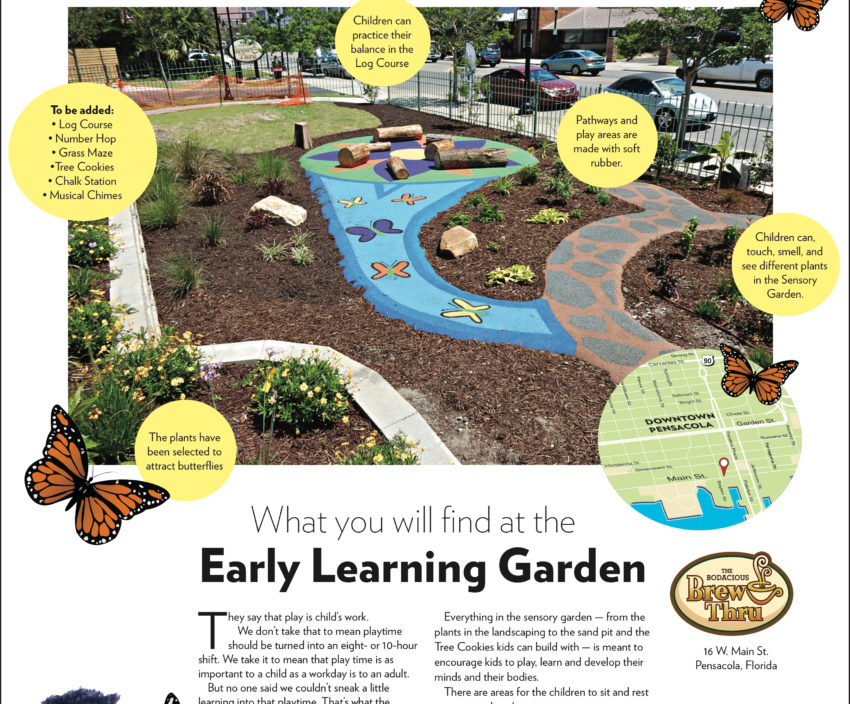Update: Early Learning Garden
- April 28, 2017
- / Shannon Nickinson
- / early-learning

A look at the Early Learning Garden at the Bodacious Brew Drive-Thru. Credit: Ron Stallcup.
What does an Early Learning City look like?
It's a question we at the Studer Community Institute have been working on for quite some time. In fact we built a series of advertisements — called the Roadmap to an Early Learning City — to help show people what we envisioned.
And to encourage all of you to add to that vision and make it come alive.
One highly visible piece of the roadmap is coming to life right and at the corner of Main and Baylen streets. The sensory garden at the Bodacious Brew drive-thru is built to support the interaction of children with nature — and of children with their parents.
Research shows that being in nature boosts a child’s brain development and ability to focus, to be creative and to solve problems. Designed by Caldwell & Associates Architects, the garden took elements of play and nature and worked to combine them into a learning space that is beautiful and fun.
The garden is one way that a group of people wove the concept of creating an Early Learning City into their area of expertise — architecture and design. If we are to succeed in our effort to boost the school readiness of all of children, we need more people to do just that.
The most recently available data for Florida education officials on kindergarten readiness comes from 2014. It indicates that of the nearly 3,000 children who started kindergarten, 34 percent were not ready for school.
That's 1,000 children.
Local education officials say that anecdotally, they don't believe that readiness rate has seen a big jump since 2014. Superintendent Malcolm Thomas has estimated that 18-20 percent of his kindergartners are as much as two years behind their peers.
One reason that many of those children lag behind their peers is something called the "achievement gap." It's a gap in school readiness in children from lower income families identified by researchers. It is linked, data suggests, to the "language environment," the kind and number of words children hear before they turn 4.
The more interaction a young child has with a loving adult who knows why it is important to talk, read, play and interact with a youngster between birth and age 3, the more likely that child is to be ready for school.
Right now, every year, Escambia County leaves 1,000 of her children a step behind. From the very first day of school.
We can't keep doing that and expect to see high school graduation rates rise.
We can't keep doing that and expect to develop a skilled workforce with the critical-thinking and problem-solving skills employers will demand. In a competitive, linked marketplace we just can't afford to leave that much untapped talent by the wayside.
We can't keep doing that and expect to improve the quality of life for everyone by lowering crime rates, increasing wages, and adding taxpayers and engaged citizens to the community.
We can't keep doing that because it is wrong. Wrong for the civic, economic and moral infrastructure of our community.
To make it right, we all need to find the part we can play in improving the lives of all of our children. And we need to play it.
 CivicCon launches with a look at good growth in cities
CivicCon launches with a look at good growth in cities
 Building stronger brains one baby, one parent at a time
Building stronger brains one baby, one parent at a time
 SCI debuts commercial on Early Learning City
SCI debuts commercial on Early Learning City
 Entrecon: World class speakers and an opportunity to sharpen skills
Entrecon: World class speakers and an opportunity to sharpen skills
 PYP Quality of Life survey 2017
PYP Quality of Life survey 2017
 EntreCon Pensacola 2016: A look back
EntreCon Pensacola 2016: A look back
 Leadership tip: getting better employee takeaways
Leadership tip: getting better employee takeaways
 Leadership tip: be interested instead of interesting
Leadership tip: be interested instead of interesting
 Leadership tip: delivering difficult messages
Leadership tip: delivering difficult messages
 Brain Bags boost Arc, Early Childhood Court programs
Brain Bags boost Arc, Early Childhood Court programs